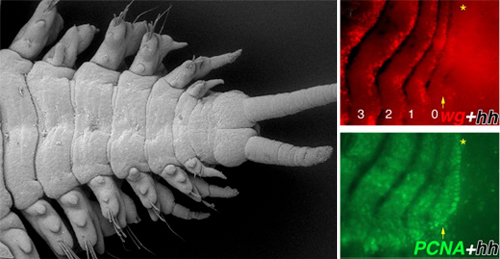| RIKEN Center for Developmental Biology (CDB) 2-2-3 Minatojima minamimachi, Chuo-ku, Kobe 650-0047, Japan |
May 9, 2013 – Segmentation is a highly successful patterning strategy in a wide range of animals, including annelids, arthropods, and vertebrates, providing both flexibility and diversity in axial subdivisions of the body. While in many taxa, the number of body segments is strictly fixed, with anterior segments specified early, and more posterior segments added from a posterior segment addition zone(SAZ) as development progresses. This zone is lost in most post-embryonic animals, meaning that segments in general cannot regenerate. But certain annelids known as polychaetes have been shown to be able to regenerate amputated tail segments any number of times. However, previous studies have indicated that the SAZ in these species lack an identifiable population of stem cells, leaving the mechanisms behind this apparently limitless regenerative capacity an open question. Nao Niwa and colleagues in the Lab for Morphogenetic Signaling (Shigeo Hayashi, Group Director) now report that posterior segment regeneration in the polychaete Perinereis nuntia relies on the provision of inductive signals from the pre-existing segment adjacent to the newly forming segment. Published in Developmental Biology, these new findings help to explain the mysterious ability of these animals to regrow body segments indefinitely.
The study began with observations of segment proliferation during the development of P. nuntia. Niwa and colleagues found that cells in the segment preceding the posterior-most region (pygidium) were in active cell cycle, while those in the terminal region remained at rest. The active cells expressed high levels of PCNA, and formed what the group called the zone of cell cycle synchronization (ZCS). As the process of segment proliferation progressed slowly during development, the group decided to study it more closely in regenerating animals, which add segments more quickly. As in normal development, regenerative proliferation of segments involved the addition of rows of cells provided by the anterior segment, characterized by expression of PCNA, with one new segment forming for each five new rows of cells. To determine the molecular mechanisms underlying this process, Niwa looked at signaling pathways common to segmentation in arthropods and vertebrates, suspecting that these might be conserved in polychaetes as well. The polychaete homolog of the Drosophila gene wingless (wg) is expressed in a stripe at the posterior edge of each segment during proliferation, and faces a similar band of the polychaete hedgehog (hh) homolog in the cell at the anterior margin of the newly forming segment. A closer observation of the expression of these genes suggested that wg, hh, and PCNA are sequentially expressed in an anterior to posterior direction during segment formation, suggestive of a central instructive role for wg in the process. This sequence plays out repeatedly during segment proliferation, such that the program reinitiates for every fifth new cell, ensuring that individual segments are consistent in length. The picture that emerges from these findings is that the P. nuntia differs from other taxa in its approach to forming new segments—rather than generate signals from the edge of the newly forming segment, the signaling in polychaete appears to move from pre-existing cells at the border of the proliferation zone, a mechanism that bears resemblance to the theory of homeogenetic induction first proposed by Spemann and Mangold in 1927. “We were surprised to find that segment formation in the polychaete differs so significantly from that in insects and vertebrates, specifically in its unique ability to regenerate segments,” says Hayashi. “I never cease to be amazed at the surprises the rich diversity of the animal world holds in store.”
|
|||||
|
|||||
 |
| Copyright (C) CENTER FOR DEVELOPMENTAL BIOLOGY All rights reserved. |
